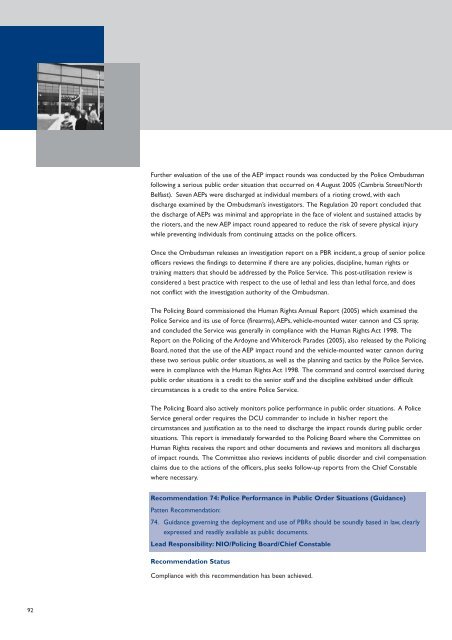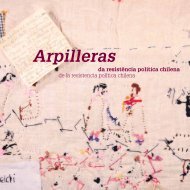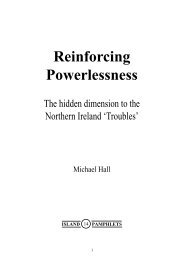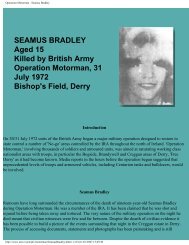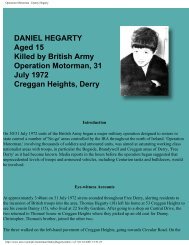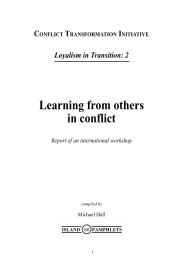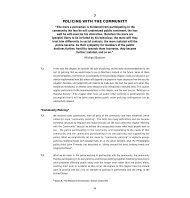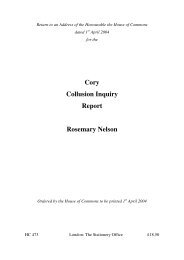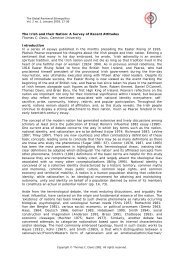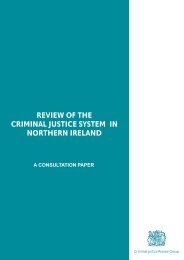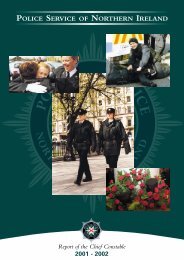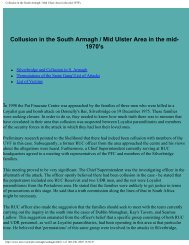11293 report 19 - CAIN - University of Ulster
11293 report 19 - CAIN - University of Ulster
11293 report 19 - CAIN - University of Ulster
You also want an ePaper? Increase the reach of your titles
YUMPU automatically turns print PDFs into web optimized ePapers that Google loves.
Further evaluation <strong>of</strong> the use <strong>of</strong> the AEP impact rounds was conducted by the Police Ombudsmanfollowing a serious public order situation that occurred on 4 August 2005 (Cambria Street/NorthBelfast). Seven AEPs were discharged at individual members <strong>of</strong> a rioting crowd, with eachdischarge examined by the Ombudsman’s investigators. The Regulation 20 <strong>report</strong> concluded thatthe discharge <strong>of</strong> AEPs was minimal and appropriate in the face <strong>of</strong> violent and sustained attacks bythe rioters, and the new AEP impact round appeared to reduce the risk <strong>of</strong> severe physical injurywhile preventing individuals from continuing attacks on the police <strong>of</strong>ficers.Once the Ombudsman releases an investigation <strong>report</strong> on a PBR incident, a group <strong>of</strong> senior police<strong>of</strong>ficers reviews the findings to determine if there are any policies, discipline, human rights ortraining matters that should be addressed by the Police Service. This post-utilisation review isconsidered a best practice with respect to the use <strong>of</strong> lethal and less than lethal force, and doesnot conflict with the investigation authority <strong>of</strong> the Ombudsman.The Policing Board commissioned the Human Rights Annual Report (2005) which examined thePolice Service and its use <strong>of</strong> force (firearms),AEPs, vehicle-mounted water cannon and CS spray,and concluded the Service was generally in compliance with the Human Rights Act <strong>19</strong>98. TheReport on the Policing <strong>of</strong> the Ardoyne and Whiterock Parades (2005), also released by the PolicingBoard, noted that the use <strong>of</strong> the AEP impact round and the vehicle-mounted water cannon duringthese two serious public order situations, as well as the planning and tactics by the Police Service,were in compliance with the Human Rights Act <strong>19</strong>98. The command and control exercised duringpublic order situations is a credit to the senior staff and the discipline exhibited under difficultcircumstances is a credit to the entire Police Service.The Policing Board also actively monitors police performance in public order situations. A PoliceService general order requires the DCU commander to include in his/her <strong>report</strong> thecircumstances and justification as to the need to discharge the impact rounds during public ordersituations. This <strong>report</strong> is immediately forwarded to the Policing Board where the Committee onHuman Rights receives the <strong>report</strong> and other documents and reviews and monitors all discharges<strong>of</strong> impact rounds. The Committee also reviews incidents <strong>of</strong> public disorder and civil compensationclaims due to the actions <strong>of</strong> the <strong>of</strong>ficers, plus seeks follow-up <strong>report</strong>s from the Chief Constablewhere necessary.Recommendation 74: Police Performance in Public Order Situations (Guidance)Patten Recommendation:74. Guidance governing the deployment and use <strong>of</strong> PBRs should be soundly based in law, clearlyexpressed and readily available as public documents.Lead Responsibility: NIO/Policing Board/Chief ConstableRecommendation StatusCompliance with this recommendation has been achieved.92


